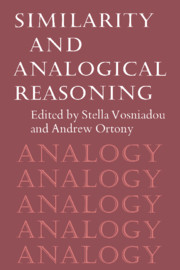Book contents
- Frontmatter
- Contents
- Preface
- List of contributors
- Similarity and analogical reasoning: a synthesis
- Part I Similarity and the structure of concepts
- Part II Analogical reasoning
- Part III Similarity and analogy in development, learning, and instruction
- Afterword: Comments on Parts I, II, and III: A framework for a theory of comparison and mapping
- Name index
- Subject index
Afterword: Comments on Parts I, II, and III: A framework for a theory of comparison and mapping
Published online by Cambridge University Press: 22 October 2009
- Frontmatter
- Contents
- Preface
- List of contributors
- Similarity and analogical reasoning: a synthesis
- Part I Similarity and the structure of concepts
- Part II Analogical reasoning
- Part III Similarity and analogy in development, learning, and instruction
- Afterword: Comments on Parts I, II, and III: A framework for a theory of comparison and mapping
- Name index
- Subject index
Summary
In our studies of human reasoning (Burstein, 1986; Collins, 1978; Collins & Loftus, 1975; Collins & Michalski, 1989) we have found that the processes of comparison and mapping are central to all forms of human inference. For example, comparison underlies categorization (Smith & Medin, 1981) in that the very act of categorizing involves a comparison between an instance and a concept. Categorization is of use to humans because it allows us to make inferences (mappings) about what properties the categorized instances will have (e.g., they may fly away, they can be turned on, etc.). As the chapters in this volume amply illustrate, analogies and metaphors are also heavily dependent on these processes of comparison and mapping.
The literature on similarity, analogy, and metaphor ranges over many different kinds of comparison and mapping processes. Our goal is to clarify the issues being addressed and the critical distinctions that need to be made. We will attempt to consider the entire territory over which the discussion of comparison and mapping arises, but no doubt we will miss some of the critical distinctions and issues.
Some of the disagreements arise because researchers are talking about different kinds of comparisons or the different contexts in which comparison and mapping processes are used. Indeed, one common confusion is due to the use of the term mapping to describe either a functional correspondence between conceptual entities, the process tjiat establishes such correspondences (which we will refer to as comparison), or the process of transferring properties of one conceptual system to another, “similar” one.
Information
- Type
- Chapter
- Information
- Similarity and Analogical Reasoning , pp. 546 - 566Publisher: Cambridge University PressPrint publication year: 1989
Accessibility standard: Unknown
Why this information is here
This section outlines the accessibility features of this content - including support for screen readers, full keyboard navigation and high-contrast display options. This may not be relevant for you.Accessibility Information
- 9
- Cited by
